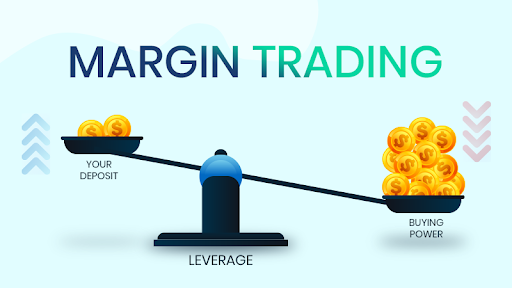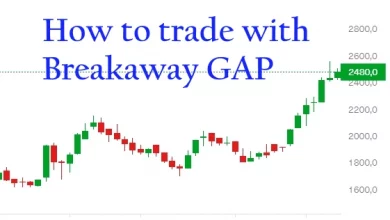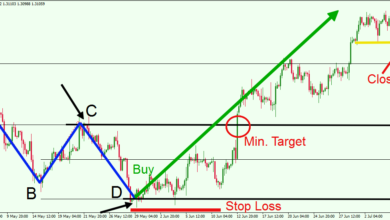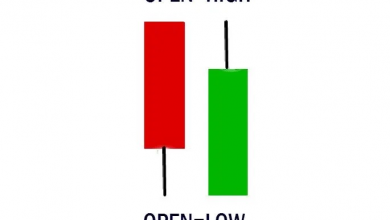What Is Margin Trading?

Margin trading is a type of asset trading in which money is offered by a third party. Margin accounts, as opposed to ordinary trading accounts, help investors to access larger quantities of money, enabling them to leverage their holdings. Margin trading basically magnifies trading outcomes, allowing traders to make bigger gains on successful trading transactions. Margin trading is highly common in low-volatility markets, such as the global Forex market, because of its potential to enhance trading outcomes. Margin trading is used as well in the cryptocurrency, stock, and commodity markets.
Table of contents
How does Margin Trading work?
A margin trade requires the trader to invest a proportion of the overall order value once it is placed. The margin is a term that refers to the original investment and is strongly connected to the notion of leverage. To put it another way, margin trading facilities are utilized to generate leveraged trading, with leverage referring to the ratio of money borrowed to margin. To open a $200,000 trading transaction with a 10:1 leverage, an investor would have to invest $20,000 of their own money.
However, various brokerage firms and trading marketplaces provide a varied set of regulations and leverage rates. Let take the stock market, for instance, 2:1 is a normal ratio, whereas the futures contracts are typically traded at a leverage of 15:1 ratio. Margin transactions are often leveraged at a ratio of 50:1 at the Forex brokerages, however, 100:1 and 200:1 are also utilized in select circumstances. The leverage ratios in crypto markets generally range between 2:1 and 100:1; and the crypto margin trading community frequently uses the ‘x’ nomenclature (something like 2x, 5x, 10x…e.t.c.)
Long and short trading positions can both be opened via margin trading. A long trading position implies that the financial asset’s price will rise, whilst a short trading position implies that the financial asset’s price will fall. The investor’s assets serve as security for the money borrowed while the margin position is open. Some brokerages have the legitimate right to compel the sale of these financial assets if the market goes against them, so traders should be aware of this.
If an investor enters a long leveraged traditional position, for example, they may get a margin call if the asset’s price falls considerably. When a trader is compelled to deposit additional cash into their margin trading account so as to meet the required margin trading criteria, this is known as a margin call. If the trader which is also referred to as an investor was unable to put in more funds, their assets will be liquidated to cover the losses they have made. This generally happens when the entire value of all the assets in a margin trading account (liquidation margin), falls below the overall margin requirements of the specific exchange or broker used by the trader.
Some Important margin trading terms
Maintenance margin, negative balance protection, Initial margin, and margin calls are some of the words you’ll encounter on your trading platform that you should be familiar with.
- Initial margin.
The initial margin, also known as the deposit margin, is the smallest amount of money that must be provided by you in order to establish a trading position.
Since this margin represents a tiny percentage of the total value of your trading position, it may not be sufficient to support your trading losses if the open market eventually goes against you. So you’ll have to keep an eye on your maintenance margin balance.
- Maintenance margin
Maintenance margin is a term used to describe the adequate amount of money you should have to keep your trades open by covering any ongoing losses. It shows the minimum amount in your trading account that you should maintain.
- Margin call
If your open trading position by any chance goes against you and your present money is insufficient to fulfill your margin need, your broker will issue you a margin call.
This happens when your trading account’s capital drops below your broker’s margin amount criteria. The broker used may then request that you put a particular amount of money into your brokerage account. And if you’re unable to pay the additional margin, your trades will be closed out by the broker.
- Negative balance protection
Stop-loss orders, also known as margin calls, aren’t always enough to save traders from losing too much money. This occurs when the market is not liquid or even when the market price changes are highly rapid and volatile, with slippage and gaps.
Features of Margins Trading
According to SEBI regulations, only approved brokers can provide margin trading accounts for traders.
The Securities and Exchange Board of India (SEBI) and the individual stock exchanges specify the securities that can be traded on margin.
Traders can construct bets in opposition to the margin using cash or shares as collateral.
Margin-created trading positions can be continued for up to the number of days the open trading position can be held forward for,(which varies per broker), plus the number of trading days.
Traders who want to use the margin trading facility should open an MTF trading account with their broker and accept the terms and conditions, stating that they understand the rewards and dangers associated.
The SEBI Regulations Vs Margin Trading
Margin trading in India was formerly only possible with cash, with the use of shares as collateral being prohibited. Traders can now leverage their trading position in the market through margin trading by giving shares as security, according to new SEBI regulations issued in 2018.
Furthermore, according to SEBI laws, margin trading accounts can only be provided by approved brokers.
How Can Investors Get Involved in Margin Trading?
Those interested in investing on margin can do that by opening a Margin Trading Facility (MTF) account with any preferred approved broker of their choice.
The Margin Trading Facility (MTF) account is a form of brokerage account in which an approved broker disburses cash to an investor for the purpose of purchasing stocks or any other financial assets. As is customary in margin trading, the leveraged loan in Margin Trading Facility (MTF) accounts is secured by cash (often called minimum margin) or assets acquired as collateral, and it comes often with a weekly or monthly interest rate.
Margin Trading strategies
Setting specific parameters and following the best strategies practice by experienced margin investors will help you employ margin leverage trading successfully:
- For the right assets, use margin.
Whether or not a margin investing approach or strategy is acceptable for a specific trading account should be determined by your trading goals. If you are a consistent and active investor, a trading account that seeks long-term profitability and can be utilized for many reasons may be the best option. However, you should avoid using margin for retirement savings or funds that are intended to support particular goals, like a home down payment or children’s school fees.
- If you’re going to invest anything on margin, be sure it’s something you have deeply research.
It is good to understand what you’re investing in before opening any position. This is especially true in a margin trade when a bad assumption might cost a lot of money. Consider firms with solid foundations and those in fast-growing industries with a proven record of long-term expansion. It’s dangerous to use margin accounts to pursue the newest hot stocks.
- Always keep it simple and short.
Margin purchases should be limited to short times, according to investment specialists. Set a maximum of one to two-month margin buy windows to avoid being exposed to unanticipated price reductions or market corrections for an extended length of time. Also bear in mind that you’ll be paying interest on the money you borrowed while keeping the trade open for a long period of time, lowering your overall return on investments.
- Margin calls should be avoided.
A margin call might compel you to sell a position at an inconvenient moment, resulting in losses or the loss of an opportunity to profit. Worse, your broker may decide to liquidate your trading account on your behalf. To avoid this, figure out the minimum maintenance you need ahead of time. It’s generally 30percent of the account’s current worth and you will have to make sure it doesn’t go below that.
- Know when it’s time to leave.
Either you’re on the winning side or the losing side of a margin trade, this is valid. Don’t become greedy if you bought a stock on margin and it went on to have a nice run. Set an initial goal price that you expect to achieve. Carefully consider the basics and think about selling if the price exceeds that. Similarly, decide how much of a loss you’re ready to accept before selling and adhere to it. One of the most typical blunders made by investors is holding on to a loss for too long.
- Test run it first.
The easiest approach to get started with margin trading is to start small with one or a few stocks. This will allow you to get a feel for the benefits, likewise the expenses and hazards, of margin trading on a modest scale. It will also enable you to develop a disciplined margin strategy prior to implementing it on larger assets.
A well-executed margin strategy may be a useful tool. However, you must be focused, disciplined, and be willing to take a significant level of risk.
Advantages of Margin Trading
The following are some of the advantages gained through this trading system:
- Great for generating short-term profit
Margin trading is great for individuals who want to earn from short-term stock or forex market price changes but don’t have enough trading capital in hand to invest.
- Leveraging the market position
Traders can use this trading method to leverage their positions in assets that aren’t derivatives.
- Maximize your profits
It helps investors to get the best possible return on their money.
- Use securities or assets as a form of collateral
Traders can trade Margin by using their trading account portfolio or securities from their Demat account as collateral.
- SEBI-regulated
The margin trade facility is constantly monitored by SEBI and stock exchanges.
Risks of Margin Trading
On the surface, the procedure appears to be straightforward. Margin trading, on the other hand, is a complex procedure that entails substantial risk. It needs a separate account known as a margin account because of the increased risks. This is not the same as a regular bank account used by most people.
When buying stock or any type of commodities, you might utilize a margin account or a cash account. Short sales, on the other hand, can only be done using margin accounts. Similarly, margin accounts are used to pay for some financial securities like futures and commodities.
The following are some of the dangers of margin trading:
1. Losses are amplified
It goes without saying that margin trading may considerably increase an investor’s profits. It may, however, exacerbate the trader losses. Of no joke, investors may lose more money than they originally put in.
Some investors believe that owing money to brokers is less difficult than owing money to banks. However, this form of debt is no significantly different from that of the bank in terms of binding.
2. Margin Call
A margin call occurs when a broker instructs an investor to deposit additional funds into the margin account so as to meet the minimum margin maintenance level that is required The margin account may fall below a particular amount if the trader’s positions have created a great loss due to poor performing securities. When this occurs, the trader will have to sell some or all of the trading account’s assets or put in more money to fulfill the margin need.
3. Liquidation
If the trader is unable to keep to his or her commitment, the broker has the authority to act accordingly, depending on the conditions of the margin loan contract. for instance, the brokerage company can liquidate any available assets in the trader margin account.
The final takeaway
Trading on margin has a far larger risk than investing directly with money. If the deal goes horribly against you, you may wind up losing even more money than you originally spent. Even if the deal goes as planned, interest rates on borrowed funds can chip away some of your gains.
Margin trading, on the other hand, may enhance your earnings and return on investment if you completely grasp the risks and expenses. It may also enable you to invest in a wider choice of securities.
Start modestly if you wish to trade with margin. Get some proven trading tips from expert margin traders. You can decrease your risk by keeping your loan amounts considerably below your entire margin trading account value and margin limitations.
Limit your margin trades position to short durations as well. This will reduce your exposure to the financial market volatility while also lowering your interest costs. Also, find yourself the best margin broker, keep a watch on the markets and be prepared to act quickly. Margin trading benefits quick-thinking; it’s not a passive investment approach.




